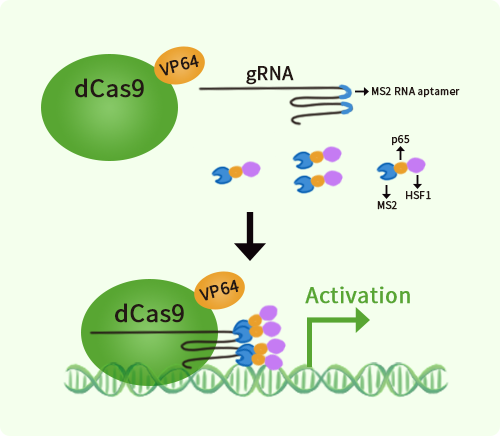Human Antizyme inhibitor 1 (AZIN1) activation kit by CRISPRa
CAT#: GA109885
AZIN1 CRISPRa kit - CRISPR gene activation of human antizyme inhibitor 1
Find the corresponding CRISPRi Inhibitor Kit
USD 1,290.00
2 Weeks*
Specifications
| Product Data | |
| Format | 3gRNAs, 1 scramble ctrl and 1 enhancer vector |
| Symbol | AZIN1 |
| Locus ID | 51582 |
| Kit Components | GA109885G1, AZIN1 gRNA vector 1 in pCas-Guide-CRISPRa GA109885G2, AZIN1 gRNA vector 2 in pCas-Guide-CRISPRa GA109885G3, AZIN1 gRNA vector 3 in pCas-Guide-CRISPRa 1 CRISPRa-Enhancer vector, SKU GE100056 1 CRISPRa scramble vector, SKU GE100058 |
| Disclaimer | The kit is designed based on the best knowledge of CRISPa SAM technology. The efficiency of the activation can be affected by many factors, including nucleosome occupancy status, chromatin structure and the gene expression level of the target, etc. |
| Reference Data | |
| RefSeq | NM_001301668, NM_015878, NM_148174, NM_001363010, NM_001363024, NM_001363083, NM_001363011, NM_001363012, NM_001363013, NM_001363014 |
| Synonyms | AZI; AZIA1; OAZI; OAZIN; ODC1L |
| Summary | The protein encoded by this gene belongs to the antizyme inhibitor family, which plays a role in cell growth and proliferation by maintaining polyamine homeostasis within the cell. Antizyme inhibitors are homologs of ornithine decarboxylase (ODC, the key enzyme in polyamine biosynthesis) that have lost the ability to decarboxylase ornithine; however, retain the ability to bind to antizymes. Antizymes negatively regulate intracellular polyamine levels by binding to ODC and targeting it for degradation, as well as by inhibiting polyamine uptake. Antizyme inhibitors function as positive regulators of polyamine levels by sequestering antizymes and neutralizing their effect. This gene encodes antizyme inhibitor 1, the first member of this gene family that is ubiquitously expressed, and is localized in the nucleus and cytoplasm. Overexpression of antizyme inhibitor 1 gene has been associated with increased proliferation, cellular transformation and tumorigenesis. Gene knockout studies showed that homozygous mutant mice lacking functional antizyme inhibitor 1 gene died at birth with abnormal liver morphology. RNA editing of this gene, predominantly in the liver tissue, has been linked to the progression of hepatocellular carcinoma. Alternatively spliced transcript variants have been described for this gene. [provided by RefSeq, Sep 2014] |
Documents
| Product Manuals |
| FAQs |
| SDS |
Resources
Other Versions
| SKU | Description | Size | Price |
|---|---|---|---|
| KN400022 | AZIN1 - KN2.0, Human gene knockout kit via CRISPR, non-homology mediated. |
USD 1,290.00 |
{0} Product Review(s)
Be the first one to submit a review






























































































































































































































































 Germany
Germany
 Japan
Japan
 United Kingdom
United Kingdom
 China
China
